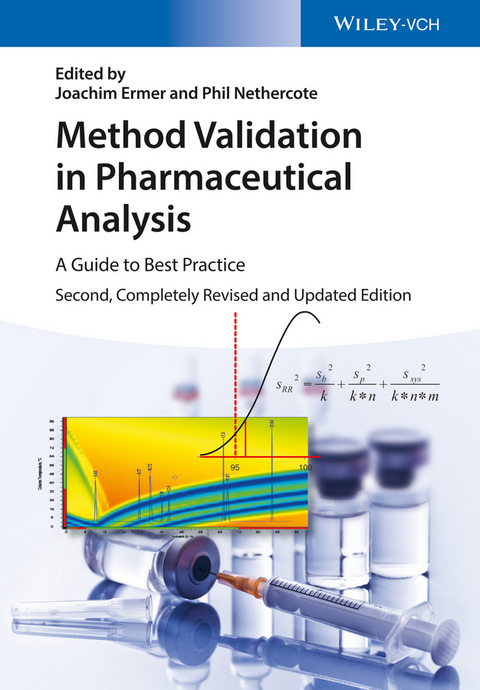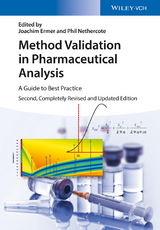Method Validation in Pharmaceutical Analysis
Wiley-VCH (Verlag)
978-3-527-33563-3 (ISBN)
This second edition of a global bestseller has been completely redesigned and extensively rewritten to take into account the new Quality by Design (QbD) and lifecycle concepts in pharmaceutical manufacturing.As in the first edition, the fundamental requirements for analytical method validation are covered, but the second edition describes how these are applied systematically throughout the entire analytical lifecycle. QbD principles require adoption of a systematic approach to development and validation that begin with predefined objectives. For analytical methods these predefined objectives are established as an Analytical Target Profile (ATP). The book chapters are aligned with recently introduced standards and guidelines for manufacturing processes validation and follow the three stages of the analytical lifecycle: Method Design, Method Performance Qualification, and Continued Method Performance Verification. Case studies and examples from the pharmaceutical industry illustrate the concepts and guidelines presented, and the standards and regulations from the US (FDA), European (EMA) and global (ICH) regulatory authorities are considered throughout.The undisputed gold standard in the field.
Joachim Ermer is Head of Quality Control Services Chemistry at Sanofi in Frankfurt, Germany, and Global Reference Standards Coordinator of Sanofi. He studied biochemistry at University of Halle, Germany, and obtained a PhD in enzyme kinetics in 1988. He has more than 20 years of experience in pharmaceutical analytics including development projects, global responsibilities as Director of Analytical Processes and Technology, and Head of Quality Control. He is member of the USP Expert Panel on Validation and Verification, of the EFPIA Quality by Design Working Group, and of the Focus Group Analytics and Quality Assurance of the International Association of Pharmaceutical Technology (APV). From 2000 till 2008, he was Deputy Head of the Working Group Quality Control / Pharmaceutical Analytics of the German Pharmaceutical Society (DPhG). His special interest has been focused early on analytical validation and related topics, such as performance evaluation, statistics, and transfer of analytical procedures.. Phil Nethercote is the Analytical Head and API Analytical Lead for the Global Manufacturing and Supply division of GSK. He has a degree in chemistry from Herriot Watt University in Edinburgh and obtained a PhD in HPLC retention mechanisms from the University of Stirling in 1987. He is a Chartered Chemist and a member of the Royal Society of Chemistry. He has over 25 years of experience in the pharmaceutical industry the majority of which has been with Glaxo, Glaxo Wellcome and GSK where he has led analytical development and new product introduction teams in the UK and in Singapore. In his current role he provides leadership for analytical systems, processes and standards across GSKs global network of manufacturing sites. He is member of the USP Expert Panel on Validation and Verification, of the EFPIA Analytical Quality by Design Working Group and led the revision of the analytical section of the second edition of the ISPE technology transfer guide He has a passion for ensuring efforts invested in Analytical Method Validation and Transfer add real value in ensuring the methods produce fit for purpose data and has been a strong advocate in applying QbD principles to help achieve that aim.
Foreword
ANALYTICAL VALIDATION WITHIN THE PHARMACEUTICAL LIFECYCLE
Development of Process and Analytical Validation Concepts
Alignment between Process and Analytics: Three-Stage Approach
Predefined Objectives: Analytical Target Profile
Analytical Life Cycle
ANALYTICAL INSTRUMENT QUALIFICATION
Analytical Instrument and System Qualification
Efficient and Economic HPLC Performance Qualification
ESTABLISHMENT OF MEASUREMENT REQUIREMENTS - ANALYTICAL TARGET PROFILE AND DECISION RULES
Introduction
Defining the Fitness for Intended Use
Decision Rules
Overview of Process to Develop Requirements for Procedure Performance
Decision Rules and Compliance
Calculating Target Measurement Uncertainty
Types of Decision Rules
Target Measurement Uncertainty in the Analytical Target Profile
Bias and Uncertainty in a Procedure
ATP and Key Performance Indicators
Measurement Uncertainty
Example
Conclusion
ESTABLISHMENT OF MEASUREMENT REQUIREMENTS - PERFORMANCE-BASED SPECIFICATION
Introduction
Intended Purpose
Identification
Assay
Impurities
Limit Tests
Quantitative Tests
Summary
METHOD PERFORMANCE CHARACTERISTICS
Introduction
Precision
Accuracy and Range
Specificity
Linearity
Detection and Quantitation Limit
Glossary
METHOD DESIGN AND UNDERSTANDING
Introduction
Analytical Quality by Design and Robustness Investigations
Case Study: Robustness Investigations
System Suitability Tests
METHOD PERFORMANCE QUALIFICATION
Introduction
Case Study: Qualification of an HPLCMethod for Identity, Assay, and Degradation Products
Design and Qualification of a Delivered Dose Uniformity Procedure for a Pressurized Metered Dose Inhaler
Implementation of Compendial/Pharmacopeia Test Procedures
Transfer of Analytical Procedures
CONTINUED METHOD PERFORMANCE VERIFICATION
Introduction
Routine Monitoring
Investigating and Addressing Aberrant Data
Continual Improvement
Index
| Erscheint lt. Verlag | 1.10.2014 |
|---|---|
| Verlagsort | Weinheim |
| Sprache | englisch |
| Maße | 170 x 244 mm |
| Gewicht | 1095 g |
| Themenwelt | Medizin / Pharmazie ► Pharmazie |
| Naturwissenschaften ► Chemie | |
| Technik | |
| Schlagworte | Analytische Chemie • Chemie • Chemistry • Drug QA/Analysis • Industrial Chemistry • Pharmazeutische Chemie • Pharmazeutische Industrie • Qualitätssicherung / Analyse in der Pharmazie • Qualitätssicherung in der Chemie • Quality assurance • Technische u. Industrielle Chemie • Validierung |
| ISBN-10 | 3-527-33563-3 / 3527335633 |
| ISBN-13 | 978-3-527-33563-3 / 9783527335633 |
| Zustand | Neuware |
| Haben Sie eine Frage zum Produkt? |
aus dem Bereich




